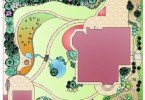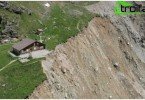It is possible to collect a good crop, preserve all buildings and provide a comfortable rest on a suburban area only if work is done to regulate soil moisture. Lack of water will destroy all living things, but excess will also cause damage. Therefore, as a matter of priority, land reclamation should be planned.
Content
- Types of land reclamation garden
- Hydrotechnical land reclamation from flooding
- Hydrotechnical land reclamation to moisten the soil
- Thermal reclamation
- Agrotechnical land reclamation
Types of land reclamation garden
Constant flooding of the soil leads to the destruction of the flora and foundation of the building, putrefactive processes, the development of bacteria. An overdried environment destroys plants. To prevent the situation, a whole range of different technical and economic activities is needed. The result of labor will be a platform on which you can build a house, stationary arbors and flower beds, grow trees, collect healthy vegetables, fruits and berries.
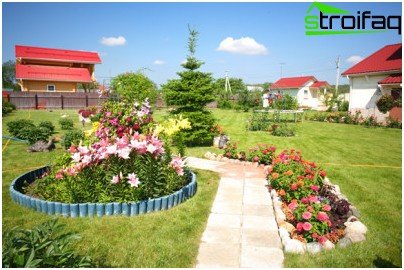
It is worth equipping the site after full preparation of the soil
Land reclamation is a paramount task, otherwise then there will be many difficulties in carrying out the work. Everything will have to be completely rebuilt. Each site requires a separate approach, so different types of land reclamation are used:
- hydraulic engineering,
- chemical,
- thermal,
- agrotechnical.
Most often they are combined.
Any types of soil reclamation should be planned for the second half of spring or summer. By this time it is easy to identify places of excessive accumulation of water or, conversely, the most arid.
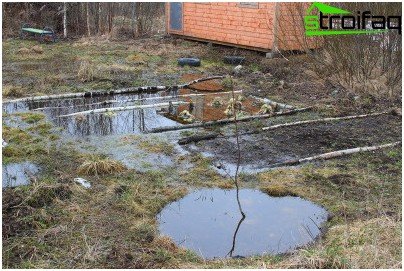
Drainage system eliminates flooding
Hydrotechnical land reclamation from flooding
It implies the installation of drainage systems, eliminates excessive waterlogging of the soil. It is necessary in the lowland, in areas where groundwater is located closely, in marshland. Otherwise, when snow melts or heavy rains, the soil may be under water..
There are various land reclamation methods to protect against flooding..
- Open
It is used at low groundwater inflow rates. Digging trenches to collect moisture. In order to exclude the escarpment of slopes over time, it is necessary to pour a sand-gravel mixture to the bottom or place a metal (plastic) casing through which water will go into the receiver (ditch, pond, collector). Be sure to close the system with a grill for safe movement around the site. Using this method, it will be necessary to take into account the location of the trenches when planning landscape design.
- Closed
With this method, trenches are also dug, only pipes are laid in them. Depth should be at least 50 cm so that the system does not interfere with the growth of garden crops and their processing, landscape work.
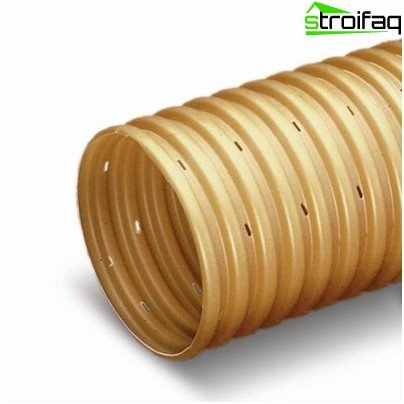
Drain pipes have holes for absorbing water
Polyethylene pipes for land reclamation with a diameter of 7-10 cm are best suited. They are lightweight, do not cause problems with installation and have a long service life. The existing perforation provides the properties of an absorbent sponge. Through micro-holes, excess water seeps in and flows into a collector or other receiver.
It is imperative to install manholes in the corners so that you can check to see if the system is clogged and if necessary lower the high pressure hose for cleaning. Pipes located in it must have a cut for the same purpose. To delay debris and sand, special baskets should be purchased. They are much easier to clean than a pipe underground.
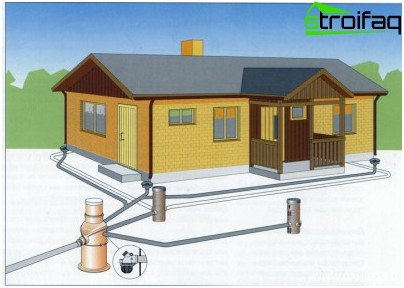
Manholes are a mandatory attribute of a closed drainage system
A layer of sand and gravel 15 cm high is poured at the bottom of the trench. It should be abundantly watered and compacted. Geotextiles are placed on top. The edges should be temporarily fixed on the walls of the trench. Large nails will do. Then pipes are laid and covered with “released” geotextiles. The design is covered with a mixture of rubble and sand. The top layer is soil excavated by digging a ditch..
- Artificial water reduction
Such amelioration of the garden site involves the use of imported soil and surface leveling. But this method is very costly and not always effective..
Hydrotechnical land reclamation to moisten the soil
This is the installation of irrigation systems to ensure the normal functioning of plants in dry weather. The system can be of several types.
- Ground watering
Used for poor soil absorption. To preserve moisture, grooves are made along the beds and seedlings or a hole-ring (bowl) around individual plants. For irrigation, a metal or plastic pipeline is laid in the area. The most common watering tool is the hose..
- Soil moisture
Leaves the topsoil dry, excluding the germination of weed seeds. Does not interfere with work on the site during irrigation.
For installation, porous polyethylene pipes with a diameter of 2-4 cm are required. Small round or slotted holes can be made independently. Pipes are usually laid at a depth of 20-25 cm.
- Sprinkling
From the name it’s clear that it is artificially created rain. The soil layer, the air above it and the ground part of the plants are moistened. This method does not require large material costs and does not degrade the structure of the soil..
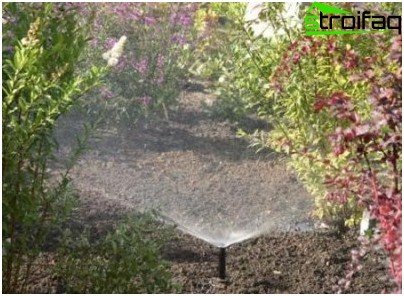
Artificial sprinkling moisturizes not only the soil, but also the air above it
Rain irrigation is suitable for areas with close occurrence of groundwater. For installation, pipes, taps and sprayers are required. The system can be welded and collapsible. The second option is more convenient, because it is easy to move around the site. The easiest option is a rubber hose in which holes are made.
Thermal reclamation
It is carried out to change the temperature regime of the upper soil layer so that it does not freeze if there is no snow cover in winter. Otherwise, the roots of perennials will be injured and will not always be able to recover..
The most common way is to mulch the soil. The surface is covered with organic and inorganic materials. In some places, compost heaps serve as insulation.
Agrotechnical land reclamation
It is carried out after completion of drainage and irrigation works. Land reclamation and land reclamation is the restoration of the landscape and the improvement of sanitary and hygienic conditions of the soil. Includes several directions.
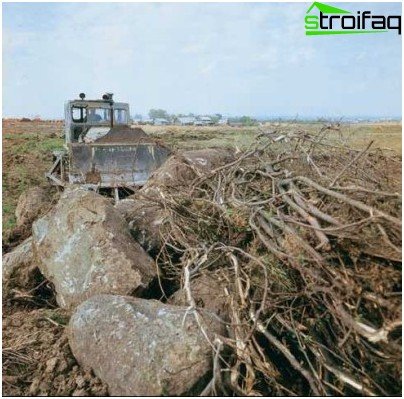
Removing debris and stones is an important step in improving soil fertility.
First of all, it is cutting down unnecessary plantations, uprooting stumps, removing debris, stones. In general, everything that can impede agricultural work. Then the damaged surface is restored.
The fertility of the soil should be improved. To do this, you can plant plants that contribute to its enrichment, or apply fertilizers.
Improving fertility
The chemical land reclamation is responsible for this. It is carried out by adding certain substances. Usually it is necessary to reduce or increase the acidity of the soil, enrich it with trace elements. It is difficult to determine this indicator on your own, so you should contact specialists.
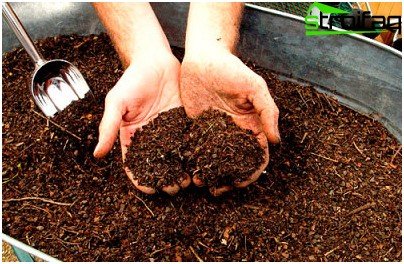
Chemical reclamation allows you to change the structure of the soil
High acidity in most plants slows down the growth of the root system and disrupts metabolic processes. To reduce the indicator, liming of the soil is carried out. Alkaline medium is usually gypsum, and depleted – phosphate.
Land reclamation
The pond sets a special tone for landscape design. It can be a pond, a pool, a fountain or a small brook. But fallen leaves, the growth of aquatic plants and the appearance of mold can spoil the aesthetic appearance, therefore, proper care is necessary. Cleaning the pool or fountain does not cause any problems, but the pond requires special treatment.
Inevitable reclamation of ponds that are inhabited by fish and plants. The work is very painstaking and tiring. The only “plus” – this should be done rarely.
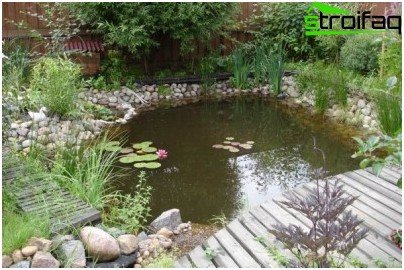
Only a well-kept pond is able to give joy
Once a year, in the spring, is it enough to replace? part of the water. A complete drainage (also after warming the soil) is required every 2-3 years, depending on the location and size of the reservoir. The event allows you to remove trash, thin out overgrown plants, enrich the water with oxygen.
Important! Before starting work, a plastic barrel or other large container filled with water from the pond is prepared to accommodate the fish. It is located in a shaded place. Amphibians need the same temporary conditions..
Water is pumped out using a long hose. When it starts to descend, the fish is caught by a net and moved to the cooked “hotel”. Be sure to cover the container on top with a net.
The sludge must be removed from the bottom and moved to the edges. For this, a broom and a bucket are suitable. Algae are removed by rake or pitchfork. Then wash the coating with a brush..
Important! Do not use detergents..
Be sure to ensure that the integrity of the coating is not damaged. To do this, you need to choose soft brushes and brooms, rubber shoes with grooved soles.
After the treatment, the pond is filled with water from a hose. Ornamental plants are immediately placed, then deep-sea.
After filling the pond with water, the fish should be acclimatized to new conditions. To do this, they are placed in small batches in plastic bags or plastic boxes filled with water from a familiar environment. In such “boats” for some time should be on the surface of the pond. After their environment takes the temperature of pure water, you can release.
At the initial arrangement of the pond, it is worthwhile to purchase special tongs and scissors that will allow you to reach dead plants located far from the coast. Then the pond will always have a well-groomed appearance, without requiring early discharge of water.
Consultation of specialists eliminates unpleasant surprises after work.
Land reclamation and restoration of the garden should be carried out even before the construction of the house. The best option would be to attract specialists, because independently determining the location of the systems and the composition of the soil is in many cases difficult, and in some cases impossible. Activities will eliminate flooding and pointless care for crops that do not bring crops. You can immediately get advice on decorating the territory.


